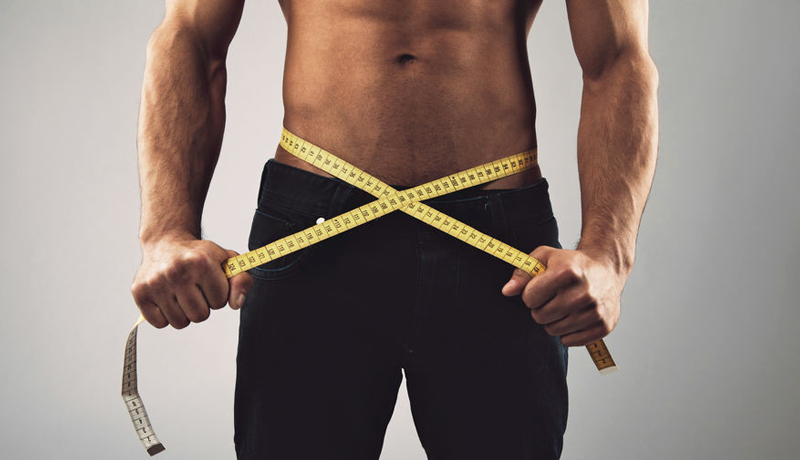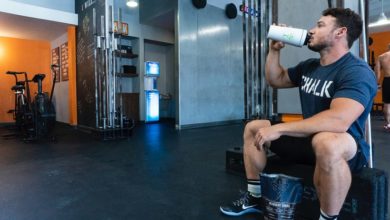
Fasted cardio is a phrase thrown around the gym every day. But, is it really better for burning fat? What about fast-tracking your weight loss goals?
We strode out into the realm of science and filled up on studies to find out…
What is fasted cardio?
First brought to light in the nineties, fasted cardio is simply the idea of training on an empty stomach. According to the advocates it’s superior for fat loss when compared to your usual fed workouts.
Since then it’s also grown in popularity not just among bodybuilders, but regular guys too. Yet, no one can really give an answer if fasted cardio is legit or not.
Is running or rowing on an empty stomach really going to get you leaner?
To get to grips with the how, we’ve got to break down the why it should work. This is the theory behind fasted cardio workouts.

Fasted Cardio Theory
There are two schools of thought behind fasted cardio. These are:
- Lower levels of insulin
- Depleted muscle glycogen
Understanding why these are supposedly a big deal is simple too. But we’ll still break them down step-by-step anyway. First up, the lower levels of insulin theory…
Lower levels of insulin theory
When you eat your morning oats, your body releases insulin. This is a hormone that allows sugars in your system to be used for energy. It’s also important for enabling your body to store unused glucose for energy.
However, fasted cardio fans have an issue with insulin. Because, as good as it is for utilizing sugars, it actually inhibits lipolysis. This is the necessary steps to breaking down triglycerides into free fatty acids for fat oxidation (AKA using fat for energy).
While ever insulin is present in higher amounts in your blood, you’ll prioritize carbs over fats for providing energy.
[infobox]So, in theory, accelerating fat burning through fasted cardio is correct. Training when insulin levels are at their lowest means more fat will be turned to as fuel during that session.[/infobox]The study: “Influence of glucose ingestion on fuel-hormone response during prolonged exercise.”
One study from 1976 confirmed this theory. They had two groups of healthy individuals perform a steady four-hour cardio session. By steady, we’re talking about 30% intensity, not a HIIT session.
To test their theory the researchers gave one group 200g of glucose 90 minutes in. What happened next was then compared to the metabolic results of the control group.
It wasn’t long after the glucose boost that the group’s metabolism swung in favor of carbs. The control group didn’t experience the same change, however, they showed a leaning towards fats for fuel [1].
Does that mean fasted cardio works best for fat loss? Well, in a way it does, but only for that specific session. We’ll get onto why so keep reading…
Key points:
- Glucose group prioritized carbs
- Control group favored fats
Reduced muscle glycogen in a morning theory
Another theory for fasted cardio is based around reduced muscle glycogen after sleep. This is the idea that your muscle’s stored energy is lower after a night of fasting during sleep.
Let’s set the scene…
Picture yourself heading out early doors for a crisp morning run. You’ve not eaten any breakfast and the only thing giving you go power is a strong black coffee. Maybe a double-dose of willpower too, or an approaching holiday.
Now, when you go out running on an empty stomach, you need energy, right? So, surely your body will start to breakdown your fat stores to fuel its six AM jog. How else would you be able to hit the 5K mark?
As you’d expect science does a pretty good job of answering this one…
The Study: “Fundamentals of glycogen metabolism for coaches and athletes”
Unfortunately, while this kind of makes sense at face value, it just isn’t true.
Recent research suggests that your glycogen stores don’t alter much overnight. Because you’re not usually active while sleeping, your muscles keep hold of this energy.
Your physique is not some kind of leaky tap.
When you wake up and lace up, there’s still fuel to spare in those legs of yours [2]. Providing you’ve eaten well the previous day that is.
Key points:
- Muscle stores glucose from carbs as glycogen for fuel
- Levels don’t alter much at rest

Will fasted cardio help you lose fat faster?
Scientists and trainers alike all agree that fasted cardio prioritizes fat for energy. The studies are all aligned here, and no one can deny it as fact.
But, will fasted cardio help you lose fat faster? This is where the black and white suddenly becomes grey.
There are actually counter arguments to suggest fasted cardio isn’t the best for fat loss. In short, it appears that both fed and fasted cardio have their benefits.
The study: “Does Cardio After an Overnight Fast Maximize Fat Loss?”
In one study from 2017, Brad Schoenfeld, a prolific researcher in his field found that fasted cardio is no more effective for fat loss than fed versions [3]. He also said that wasn’t any more ineffective either.
One vital aspect he brings up is that we need to consider fat loss as a long game. Rather than focus on a single session, we should consider our results over time. After all, noticeable changes in body composition never happen overnight.
In his paper he outlines that those who exercised in a carbohydrate fed state burned more fat for fuel post-workout than the fasted group. Effectively, this can balance out the heightened fat oxidation that occurs during fasted cardio.
Another key point Schoenfeld brings up is that food increases the thermic effect of exercise. The study he cites found that those who drank a glucose-milk drink before training saw higher levels of EPOC after their session. Simply put, they burned more calories after they finished their workout [4].
Key points:
- Fat burning for fuel increased in fed cardio group
- EPOC higher in fed cardio group
- Fat loss should be considered a longer process, not a single session
Other fasted cardio factors to consider
It turns out that research indicates fasted cardio is neither better or worse for fat loss. The same can be said of weight loss and calorie burning is your overall aim too.
There are other outside aspects to consider though…
- Cardio type
What type of fasted cardio is the best?
When it comes to crushing calories and blitzing fat, not all cardio was created equal. To the untrained eye it all looks the same but in actual fact, intensity matters.
Time and time again researchers have found HIIT cardio to beat all newcomers. High-intensity interval training is not only time-efficient but a killer for wiping out calories.
Many studies state HIIT as superior for long term fat-loss. The intensity ramps up in-session calorie burn, promotes higher rates of EPOC, and is usually more time efficient than steady state too [5] [6].
Not only that but the nature of these short, sharp sessions can push your fitness to new limits [7]. Going hard in on a HIIT session is proven to bolster both aerobic and anaerobic work capacity.
You might be wondering what happened to that sweet spot at sub-60% intensity. Something better known as the fat burning zone…
While it’s true your body turns to carbs over fats as intensity increases, there’s a method to HIIT’s madness. Research shows that regular HIIT teaches your muscles how to use less carbohydrates during exercise. As a result, you become better at oxidizing fat in the long run [8].
That doesn’t mean you can’t do steady state stuff
But what if you don’t like HIIT? Isn’t your usual jog around the park enough?
Don’t sweat it if you don’t rush for your headphones and grab a water bottle at the slightest mention of HIIT. For some people the intensity just doesn’t suit their training or lifestyle. Guess what? That’s totally fine.
When it comes to fat loss, weight loss, and calorie burning, the results come from adherence. The best kind of cardio is always the one you’ll routinely stick to.
If you can find the type of exercise you like you’re more likely to hit your goals. Being out there doing what you enjoy means you’ll keep on doing it. At the end of it all, long term consistency trumps short term intensity.

Final word on fasted cardio for fat loss
Ever since we hit the new millennium, fasted cardio has made waves in the fat loss forum. Yet, when you look at the evidence, it’s clear to see it doesn’t carry as much weight as before.
The short of it is that fasted cardio does increase fat burning. But it’s only within the space of that single session.
Fed cardio however seems to boost fat burn post workout. Plus, there’s the added factor that fed people usually feel like they can train harder.
But at the end of the day the evidence is inconclusive and neither one comes out as definitively ‘on top’.
Both fed and fasted cardio seem to balance out one another. There are equal pros and cons for both, while the studies carried out aren’t that definitive. This is because they’re usually carried out over shorter time frames or feature small test groups.
So, what’s the verdict?
Let your personal preference be the decider. It’s all down to your own feel for fasted cardio.
Fat loss should really be looked at over the course of days or weeks. So, if you can find a type of cardio you can stick with, go for it. The one that works best is the one you’ll keep on doing.
More fat loss focus you might like:
- How to Stay Shredded All Year Around – Even When Bulking
- Body Recomposition: Bodybuilding’s Biggest Secret
- 7 Steps to Getting a Perfect Shredded Body
References
- Ahlborg G, Felig P. Influence of glucose ingestion on fuel-hormone response during prolonged exercise. J Appl Physiol. 1976;41(5):683-688. doi:10.1152/jappl.1976.41.5.683
- Murray B, Rosenbloom C. Fundamentals of glycogen metabolism for coaches and athletes. Nutr Rev. 2018;76(4):243–259. doi:10.1093/nutrit/nuy001
- Schoenfeld B. Does Cardio After an Overnight Fast Maximize Fat Loss?. Strength Cond J. 2011;33(1):23-25. doi:10.1519/ssc.0b013e31820396ec
- Lee Y, Ha M, Lee Y. The effects of various intensities and durations of exercise with and without glucose in milk ingestion on postexercise oxygen consumption. J Sports Med Phys Fitness. 1999;39(4):341-7.
- Boutcher SH. High-intensity intermittent exercise and fat loss. J Obes. 2010;2011:868305. doi:10.1155/2011/868305
- Zhang H, Tong TK, Qiu W, et al. Comparable Effects of High-Intensity Interval Training and Prolonged Continuous Exercise Training on Abdominal Visceral Fat Reduction in Obese Young Women. J Diabetes Res. 2017;2017:5071740. doi:10.1155/2017/5071740
- Boutcher S. High-Intensity Intermittent Exercise and Fat Loss. J Obes. 2011;2011:1-10. doi:10.1155/2011/868305
- Talanian J, Galloway S, Heigenhauser G, Bonen A, Spriet L. Two weeks of high-intensity aerobic interval training increases the capacity for fat oxidation during exercise in women. J Appl Physiol. 2007;102(4):1439-1447. doi:10.1152/japplphysiol.01098.2006







The adherence is the key point. If you can mantain your workout adherence, you can burn fat like a beast. Studies have shown that HIIT has more adherence than steady state cardio. So, others studies shows that people preferred steady cardio. Talk with your coach that plan a worktout that fits for you and reach your goals. Remember, how much stress you do yo your body using varying methods, this will better for fat burning. Refards!
fasted cardio is really amazing. Good work. It is a very helpful content.